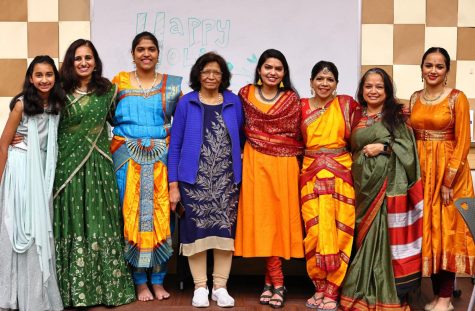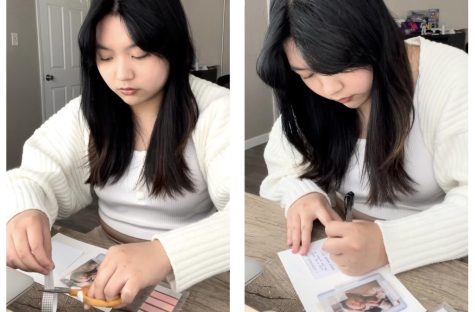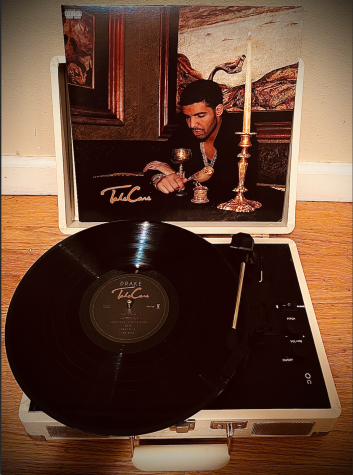Art imitates death

Dave Newlands/The Skyline View
One of the artworks on display in the Skyline College Gallery during the “Dia de los Muertis” showcase.
While Halloween still reigns supreme north of the border, Skyline has an art gallery full of reasons to add Día de los Muertos to your holiday repertoire.
On Oct. 31 children all across the country will be dressing up in adorable or spooky costumes for trick-or-treating, and adults will be dressing up in less respectable attire for less savory reasons all in the spirit of Halloween. For many cultures, however, Halloween, or All Hallows Eve is just the beginning of the Day of the Dead, a three-day celebration encompassing All Hallows Eve, All Saints Day, and All Souls day.
The Skyline art gallery has been celebrating the holiday since Oct. 13 with a student exhibit featuring art created by individual students, clubs, and programs from the Skyline student body.
“We like to honor the traditions from different cultures in the world and Día de los Muertos is a great opportunity to do that,” said Gallery Director Paul Bridenbaugh. “It’s a big holiday here in California as well as Mexico. I found that people are really enthusiastic about the holiday and it’s a really great one, visually.”
The most obvious piece is parked in front of the theater – the car-turned-altar, which the auto tech students work on each Wednesday at noon – and has become a recent fixture of the Skyline landscape.
“We’ve got so many students saying it’s exciting, it’s interesting, can we be a part of this,” Soledad McCarthy, Skyline program services coordinator said. “So we’ve just been adding on students who want to collaborate because it’s been this student art piece that’s right in the middle of campus so it’s been a blessing.”
A trip to the gallery reveals so much more than the car that can hardly be missed by passersby. Inside are more altars, informational installations, sugar skull inspired sculptures and paintings, and so much more all surrounding the centerpiece: a day-glow skeleton beckoning to onlookers from a scrap-wire swing hanging from the ceiling.
Beyond the art, the gallery show offers many opportunities to watch the students creating their works. On any given day, one can find students painting, assembling, or hanging their art, and they are proud to talk about what it is they are up to, and what their pieces mean to them.
Many Americans, especially Californians are familiar with Day of the Dead, but the celebration has yet to find a major following in the States, like it has in Mexico and other Latin American countries where Halloween as we know it is just as foreign a concept. It is precisely that Latin American influence present in Skyline’s community that garnered such enthusiastic support for this show.
Students and faculty alike were eager to share their heritage through the important ritual of celebrating the lives of the deceased. The bright colors and festive artwork characteristic of the holiday are symbolic not of mourning but of the love the living still have for those who have passed.
“I lost my brother a couple months ago due to gang violence, so I’m just rejoicing over our loss, not being sad about it,” First Year Experience student Mark Fonseca said. “Even in some Latin American cultures, I guess it’s only natural that you’re going to grieve at first, but I think that’s a big difference (between the cultures), celebrating instead of only grieving or feeling sad or being angry, celebrating their life and celebrating their death. I think it’s a little better that way.”
The FYE program is working on an altar that features six-word poems written by the students about loved ones they have lost, but it is, like the car altar, an ever-changing project.
Ultimately we’re still putting it together,” Fonseca said. “We haven’t found out yet (what it will look like). There’s still another class that we have to work around that’s also going to add their stuff to it.”
While the Latin American community at Skyline is certainly taking the show to heart, the Anthropology Club is showing a series of pieces that explain similar holidays that are celebrated in a variety of cultures. Holidays featured in the club’s display range from the Philippines who adopted the holiday during Spanish colonialism, to China where celebrants seek to ease the suffering of the deceased at a time when the spirit world and living world are thought to be unbounded.
All students were encouraged to get in on the show, and the brightly painted skeleton that serves as the gallery’s centerpiece is a testament to that. It was created by the gallery practicum class, a curriculum that doesn’t include creative arts, but rather, focuses on the management and operations side of things.
“Normally they help me run the gallery and I teach them about the logistics of working in the gallery, it’s just that they wanted to do it,” Bridenbaugh said. “I find that a lot of the students who are in my gallery class are very artistic so it’s not very surprising.”
The show itself is full of surprises. As it evolves over the course of the run there are new developments to see every day. Not only are pieces being added but certain existing exhibits are changing all the time as students add to or alter them.
“It’s kind of fun to see it more than once because its developing,” Bridenbaugh said. “The altars are being built in location so each week it’s different and were documenting that on our website.”
The reception for the show will be held on Nov. 5 in the gallery, and will feature live music. The artists will be present to discuss their work which will be displayed until Nov. 7. Next up for the gallery will be a student digital art exhibition running from Nov. 19 to Dec. 12, and the art faculty exhibition from Feb. 2 to March 7.











